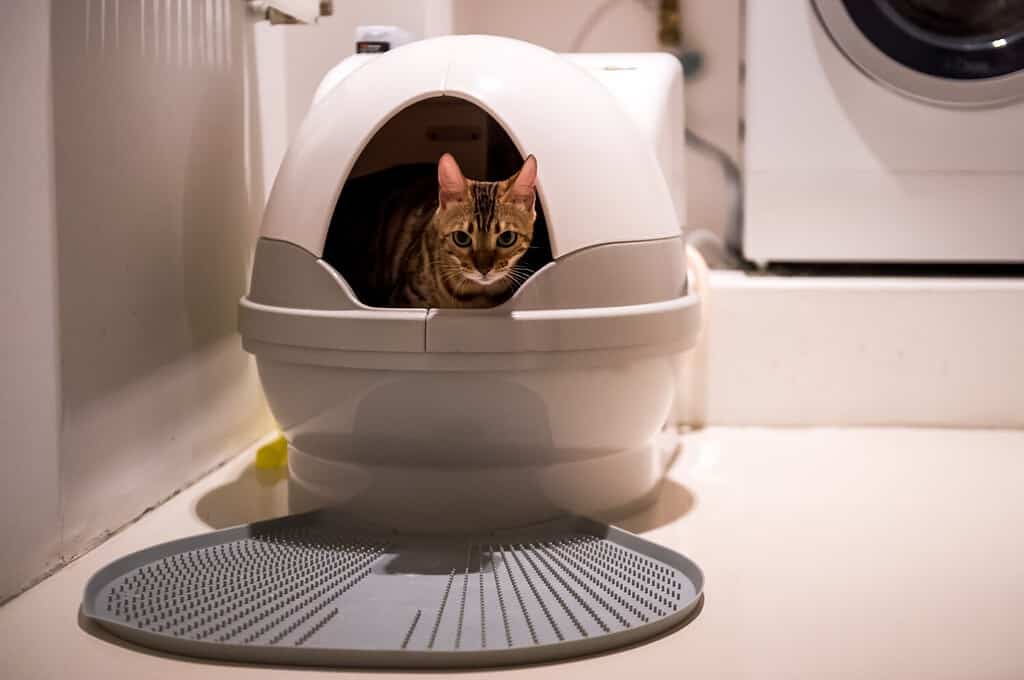When there is an increase in thyroid hormone production as a result of an enlarged thyroid gland in cats, it’s called hyperthyroidism (also known as thyrotoxicosis). With thyroid hormone production out of whack, your cat experiences a range of symptoms and may develop related diseases. However, treatment outcomes are positive. Learn about hyperthyroidism in cats, including causes, symptoms, and treatment!
Hyperthyroidism in Cats: Causes, Symptoms, and Treatment
What Causes Hyperthyroidism in Cats?
Benign Tumor
In most cases of hyperthyroidism, the culprit is a benign tumor called an adenoma.
Diet
Interestingly, some fish-flavored wet foods (canned) have been linked to the development of hyperthyroidism in cats.
Age

Middle-aged and older cats are more likely to develop hyperthyroidism.
©koldunova/iStock via Getty Images
Hyperthyroidism occurs often in cats, but there isn’t a genetic predisposition for the condition. In most cases, hyperthyroidism occurs during middle age and older kitties. On average, cats receive this diagnosis around age 13.
PBDEs
Flame-retardant chemicals, also known as PBDEs, may be present in your home furnishings. These chemicals go airborne and get circulated throughout your home and have been linked to the development of hyperthyroidism in cats.
Thyroid Cancer
It’s rare for hyperthyroidism to develop as a result of thyroid cancer. Nevertheless, it has occurred.
What are the Symptoms of Hyperthyroidism in Cats?
Hyperthyroidism presents with several different symptoms. If you notice any of the following in your kitty, consult with your veterinarian to determine the underlying cause, be it hyperthyroidism or something else.
Vomiting and Diarrhea

Your kitty may experience some gastrointestinal discomfort if it has hyperthyroidism.
©279photo Studio/Shutterstock.com
A kitty that gets into something it shouldn’t or one that has recently tried a new food may vomit or have diarrhea. If it’s a stand-alone event with a noticeable cause, keep an eye on your feline friend. But if these symptoms are accompanied by others, it’s a good idea to schedule a vet visit.
Changes in Behavior
Your typically fastidious groomer may suddenly be sporting an unkempt appearance. Your cat may actually look sickly. You may also notice hyperactivity — not the zoomies kind but a restlessness that keeps them unable to settle. Additionally, you may start to notice uncharacteristic aggression.
Breathing Changes
Cats with hyperthyroidism may also experience difficulty breathing, which is known as dyspnea. You may also notice rapid breathing, which is known as tachypnea.
Increased Appetite and Weight Loss

A cat with hyperthyroidism may be extra hungry but still lose weight.
©AlexanderDubrovsky/Shutterstock.com
Your kitty may display more hunger than usual. But despite having more of a ravenous appetite, they may also experience weight loss.
Rapid Heart Rate
Your cat’s heart rate may be rapid, or it may experience heart murmurs.
Changes to Nail Appearance
Your cat may also have thickened nails as a result of hyperthyroidism.
How Is Hyperthyroidism in Cats Diagnosed?
To diagnose hyperthyroidism, your vet looks for standard symptoms and checks the levels of thyroid hormone in your kitty’s bloodstream. Since symptoms of hyperthyroidism overlap with other conditions, your vet will follow through with additional testing to ensure a dependable diagnosis before moving forward with treatment.
How Is Hyperthyroidism in Cats Treated?
Dr. Colleen Wallace, a cat-only vet at Cozy Cat Veterinary Hospital in Raleigh, NC, told A-Z-Animals, “There are two main ways to treat hyperthyroidism in cats. The first and much preferred method is radioactive iodine therapy, which is the way people with hyperthyroidism are often treated. It involves sending a cat to a specialized facility where the cat can be boarded during treatment. It is given a painless injection of radioactive iodine, which gathers in the thyroid tissue and kills the cancerous cells. The cat then stays at the facility until it is no longer radioactive, which takes about a week. With this method, the disease is totally and permanently eliminated in 90% of the cats.”
She went on to explain, “The second method is to give a medication called methimazole, which sequesters the excess thyroid hormone circulating in the bloodstream and makes the thyroid hormone unavailable to the cells. By doing this, the thyroid hormone can be regulated for a time, but since it does not affect the thyroid tumor itself, the disease will progress. As this happens, you will need to monitor the growth of the tumor periodically with lab work and increase the amount of medication as needed to keep up with tumor growth. As there is an upper limit to how much of the medication a cat can tolerate, this method will only work for two to three years and, as such, should only be limited to older cats. Some veterinarians use Hill’s Science Diet y/d food, but it does not regulate the thyroid level very well and organ damage continues. I do not recommend it for my patients.”
The photo featured at the top of this post is © bru_greg/iStock via Getty Images
Thank you for reading! Have some feedback for us? Contact the AZ Animals editorial team.







